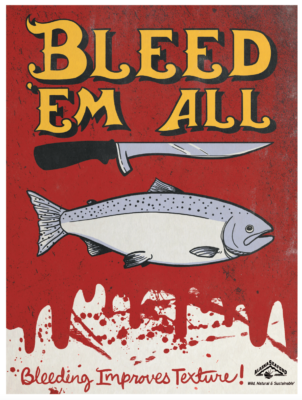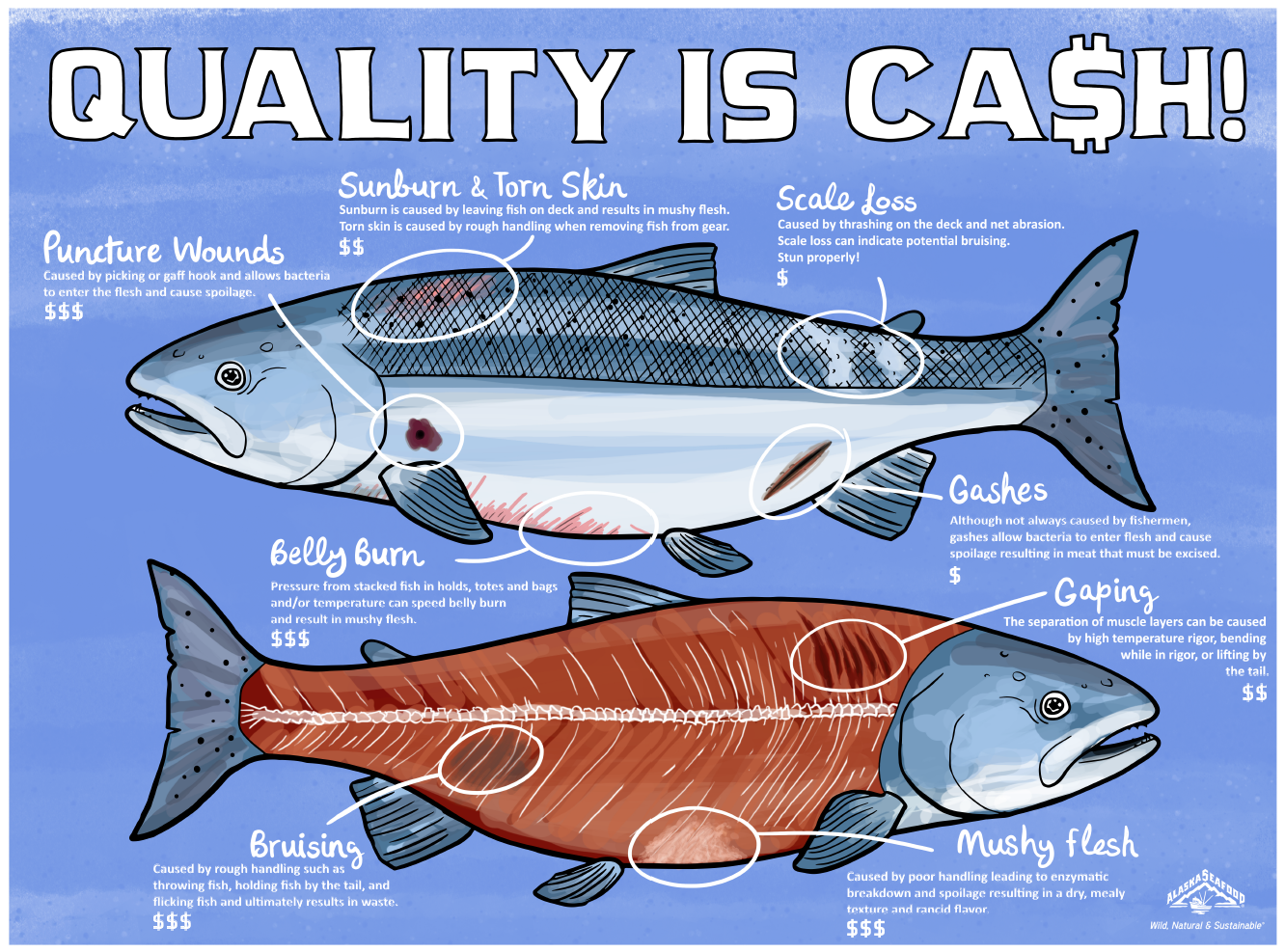Three main factors determine market share for the Alaska seafood industry: price, quality and marketability (consumer awareness and preference).
Quality has a direct effect on market price and trade economics; is a parallel factor to food safety; affects the taste, texture and nutrient composition, and the overall high-quality image expected by the markets and consumers. Preservation of quality and accurate grading and assessments of fish quality are critical components to set prices, increase competitiveness, influence food safety measures, and prevent food wastage resulting from conservative product shelf-life estimates.
If quality is arguably the most important factor for the seafood industry, how should we define it? How do you accurately grade and consistently assess the quality of seafood? How do you educate and communicate seafood quality through the supply chain?

Bleed 'Em All: The Alaska Seafood Marketing Institute's Seafood Technical team promotes quality handling with artwork designed by Alaskan Pat Race inspired by 20th-century Works Progress Administration artwork.
When the state of Alaska established the Alaska Seafood Marketing Institute in 1981, it began an initiative to work with the Alaska seafood industry and experts in the field of seafood quality to answer these questions. Alaska is one of the few seafood producing regions in the world that has quality written in the state statutes. This distinguishes the importance of quality from an industry that produces close to 60 percent of the nation’s seafood, more than all other U.S. states combined.
To address quality, ASMI is armed with a technical program that has a dual purpose. The program provides educational resources to consumers, trade, and industry members to assure safe, quality seafood is harvested and processed from Alaska’s waters. The program is also engaged with quality research, education, and the development and application of market-oriented specifications for the Alaska seafood industry to help harvesters and processors get the most out of their catch and ensure the highest quality of seafood products.
Seafood quality is the sum of the quality characteristics of seafood that are acceptable to the party judging quality. External factors of appearance (size, shape, color, odor, and consistency) and taste (texture and flavor), as well as internal factors (nutrient composition, physiological and microbial) comprise the holistic suite of quality characteristics of seafood. A producer or marketer might judge quality according to size, consistency, or shelf life, while a consumer might judge on taste and nutrient composition. This varied audience influences a subjective and somewhat general view when it comes to defining the quality of seafood.
This suite of quality characteristics of wild Alaska seafood can be divided into two important components: intrinsic and extrinsic. The intrinsic quality of seafood is the inherent physiological characteristics in fish species. Essentially, intrinsic factors define the quality of the seafood before it is harvested. Some factors that influence intrinsic quality are the quality of the fish habitat, the natural variation in size and color of harvested seafood varieties, and the different seasonal and life history variables affecting physiological characteristics. The seafood industry in Alaska is blessed with the best environment in the world to harvest wild fish, but at the same time is challenged by the natural variability of a wild harvested seafood product.
This challenge shifts emphasis to the efforts to maintain the extrinsic quality characteristics, or the factors affecting quality after the harvest. Some factors that influence extrinsic quality are onboard and processor handling and storage conditions and practices. Additionally, applying supply chain systems can extend shelf life — such as packaging technology, freezing technology, certain distribution methods, and foodservice and retail handling and storage practices — to maintain quality after harvest.
Extending shelf life has been a key component of Alaska’s seafood industry because of its remote harvesting locations and logistics of transport of product to global markets. Education on quality has also been a key component of the program.
In order to provide clarity to Alaska’s seafood buyers and consistency in statewide grading practices, more than two decades ago ASMI worked with the industry to develop quality specifications for the different groups of seafood species harvested in Alaska; salmon, whitefish and shellfish. ASMI also helped develop quality grading resources for wild salmon produced in Alaska in the form of skin color guides, illustrating maturity changes as well as meat color guides for the species of wild salmon harvested in Alaska.
Applying consistent quality specifications and grading standards to multiple wild fisheries caught by different gear types and user groups in Alaska with a variety of producers, marketers and traders is no small task. Increasingly, the Alaska seafood industry is customizing its approach to providing products that meet quality specifications for customers and investing in harvesting techniques and quality assurance programs to convey a commitment to quality.
However, even with new objective tools to identify quality specifications and grading methods, the seafood industry relies on the unique, institutional knowledge of the product-specific quality evaluators and educators to convey quality. And if you ask me, that is one aspect that differentiates the wild Alaska seafood products from the commodity fish proteins available globally. To understand the quality of a wild Alaska seafood product, the quality assessor should take the time to be educated on the unique quality characteristics and become intimately involved in the origin of that specific product, which is why education and outreach on quality is an important component of Alaska’s commitment to quality.
Education on the importance of quality for Alaska seafood begins the moment the fish is harvested. Maintaining quality at the harvester level is the first priority for quality in the Alaska seafood industry. With seafood, the quality of a product can never be improved, only maintained. Quality handling and storage practices like chilling, bleeding, icing and quick delivery are encouraged and incentivized with higher payouts by seafood processors for higher quality fish. These quality incentives can be upward of 50 cents per pound and have created a threefold increase in chilling rates for certain fisheries in the past decade. The ASMI technical program has been instrumental in providing recommended quality guidelines and educational material for fishing, tendering and processing operations in Alaska.
Distributors and seafood sellers also play an important role in maintaining quality and reducing waste. With approximately 30 percent of fish and seafood losses in the United States occurring at the consumer level, maintaining the chain of custody for quality is of clear importancet. When educating consumers to be able to ascertain a high-quality seafood product, it is suggested that a consumer find a reputable seafood seller to convey quality. It is this unique characteristic of the seafood supply chain that identifies the crucial role the myriad of quality ambassadors (chefs, waiters, fishmongers, retail seafood counter representatives, distributors, seafood product purchasers) have in educating consumers on the quality of Alaska seafood. At ASMI, we address educational needs for these ambassadors through online trainings, in-person education opportunities, familiarization experiences, outreach material, as well as appearances at events to promote awareness of the quality characteristics of Alaska seafood.
With the increase in market competition and diversity with other proteins and alternative seafood products, now more than ever there is a call to action for the entire seafood industry to direct attention to production, education and outreach regarding quality. The Alaska seafood industry continues to make strides in its commitment to quality, and we look forward to sharing this commitment with the world.







